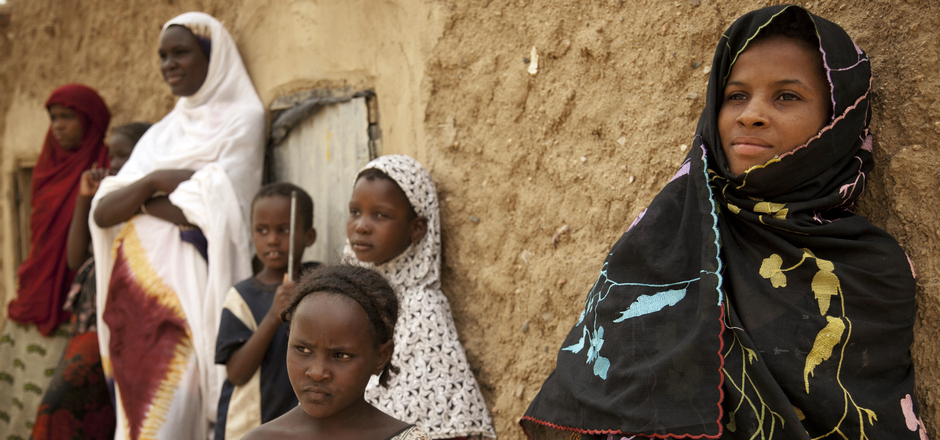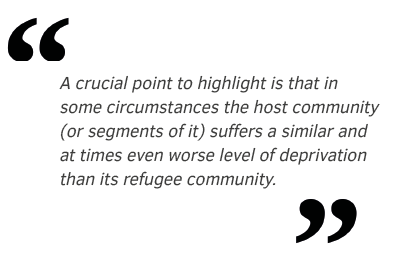
Malian girls stand in the shade in Kidal, North of Mali. Photo MINUSMA/Marco Dormino
With little prospect of peace in the world’s major trouble-spots, and without a sustainable and holistic solution to long-term human development needs, the number and vulnerability of the world’s refugee citizens is likely to grow. It is fitting therefore that we launch this series on 20 June 2018, as the international community marks World Refugee Day. In this blog series we’ll explore many related problems – and possible solutions – from both a justice and governance perspective.
…
A joint post by Dr. Zina Nimeh, Tamara A. Kool, Francesco Iacoella, and Alexander Hunns.
In line with UN commitments ‘to leave no one behind’, social protection is a strategic approach for cutting poverty and improving resilience, based on strengthening the links between humanitarian aid and development. Extending coordinated social protection provisions to refugees could be the bridge from rapid response measures in crisis situations to medium and long-term development targets as sought by the Social Protection Inter-Agency Coordination Board (SPIAC-B). This post tackles the complex question of extending social protection benefits to refugees.
Refugees seldom enjoy the same social rights as citizens of the host country in which they reside – despite the fact that social protection measures featured in the 1951 Refugee Convention, and were emphasized in 2016 in the New York Declaration for Refugees and Migrants, and in 2017 at the Social Protection in Context of Fragility and Forced Displacement Conference.
Notwithstanding the intractability of many refugee situations, there has been little long-term investment on the part of the international community to create a new holistic system that bridges the humanitarian-development nexus. There are a few exceptions to this, which could arguably provide a basis from which progress can be made.
Elements of shock-responsive social protection design may have a role to play in this scenario. A study by Oxford Policy Management (OPM) identified five helpful mechanisms to deal with natural disaster and Internally Displaced Persons. Of these, shadow alignment appears to be the most relevant to the refugee context. Shadow alignment of humanitarian response allows for incorporation of the programme with current or future social protection programmes. An example includes the case of Mali where humanitarian aid has the same value and frequency in North Mali as in South Mali; or the case of Emergency Social Safety Net (ESSN) in Turkey where the programme is run by Turkey’s existing social assistance offices and harmonised according to national social protection schemes already in place. Within the ESSN, Syrian refugees are registered within the national system to allow for eventual incorporation into national schemes in case they are granted citizenship. One or many of these solutions could be applied. Nonetheless, how much this helps depends on politics, regulations, capacity, and fiscal space.
Recently the UNHCR carried out a mapping of social safety nets (SSN), which aimed to explore potential alignment between humanitarian cash assistance and SSN in forced displacement situations. It considered various aspects of SSN, including programme design, targeting and the legal and regulatory framework. Out of 18 countries studied, the mapping found that inclusion can happen in four countries; may be possible in 10 countries; and will be challenging in the near future in four countries. Alignment as a long-term sustainable solution is, therefore, certainly possible.
The question however remains not just in how response measures such as cash transfer programmes should be designed but to what extent alignment to other social protection components, such as access to education, access to livelihood and access to health, should be included. Evidence shows that the success of unrestricted cash transfer programmes depends on markets, objectives and interaction with other types of aid. It can help savings and allow for smoothing of consumption, as it may take away an element of concern, such as the example of cash grants in Jordan used by beneficiaries to pay rent — thus opening up money for costs related to education.
 Extending social protection to refugees is not a straightforward matter. It is challenging and will very much depend on the context. A crucial point to highlight is that in some circumstances the host community (or segments of it) suffers a similar and at times even worse level of deprivation than its refugee community. Any new system must therefore be sensitive to this. Crucial elements that ought to be considered include a vulnerability assessment, mapping of existing social protection programmes, and a fiscal analysis. The above steps are paramount if there would be a chance to move towards a more sustainable future for those affected. Thus, humanitarian assistance takes on a broader role: of not only temporarily assisting but rather building a base for more medium and longer‐term development and future government scale‐up. This all begins with the political will by all stakeholders to recognise and understand the context.
Extending social protection to refugees is not a straightforward matter. It is challenging and will very much depend on the context. A crucial point to highlight is that in some circumstances the host community (or segments of it) suffers a similar and at times even worse level of deprivation than its refugee community. Any new system must therefore be sensitive to this. Crucial elements that ought to be considered include a vulnerability assessment, mapping of existing social protection programmes, and a fiscal analysis. The above steps are paramount if there would be a chance to move towards a more sustainable future for those affected. Thus, humanitarian assistance takes on a broader role: of not only temporarily assisting but rather building a base for more medium and longer‐term development and future government scale‐up. This all begins with the political will by all stakeholders to recognise and understand the context.
As many refugee crises have become protracted and continuous, short-term conceptualisations have become long-term problems. There is increasing awareness within the international community of the need to shift to a more long-term perspective. Building on this momentum the time is ripe to emphasise the case for a new form of social protection on cosmopolitan foundations: bringing together existing systems and a groundswell of support for a more inclusive and transformative model; a model backed by the political, moral and financial will of all stakeholders.
ANY COMMENTS?
NOTA BENE
The opinions expressed here are the authors’ own; they do not necessarily reflect the views of UNU.
MEDIA CREDITS
UN Photo/Marco Dormino



